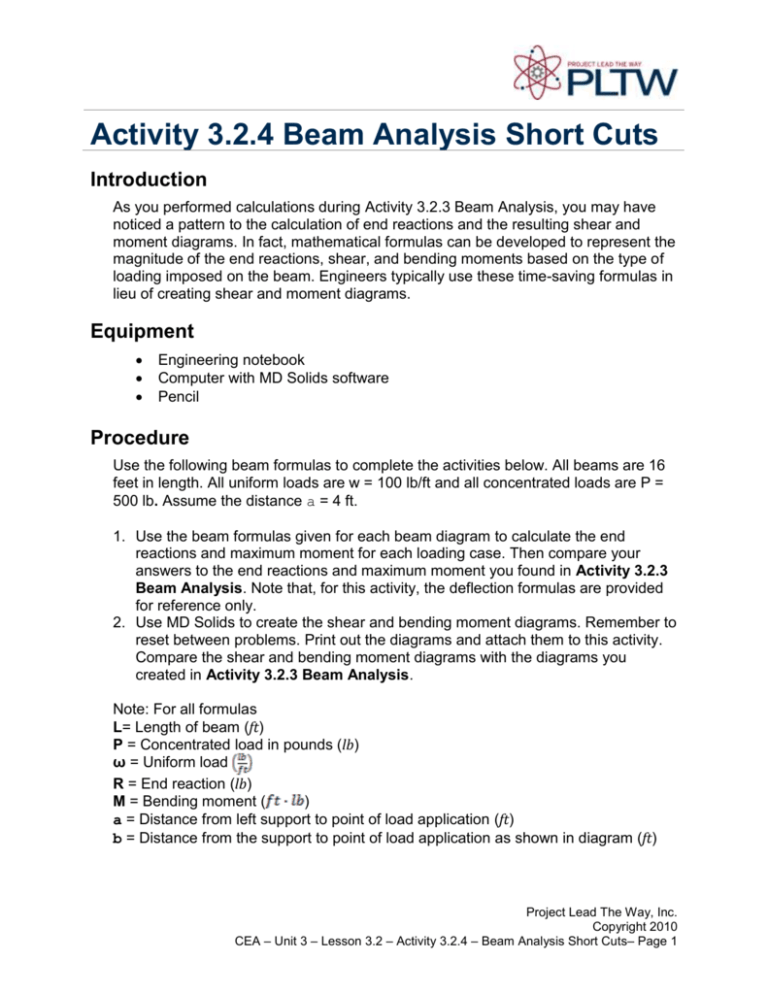Activity 3.2.3 Beam Analysis Short Cuts
advertisement

Activity 3.2.4 Beam Analysis Short Cuts Introduction As you performed calculations during Activity 3.2.3 Beam Analysis, you may have noticed a pattern to the calculation of end reactions and the resulting shear and moment diagrams. In fact, mathematical formulas can be developed to represent the magnitude of the end reactions, shear, and bending moments based on the type of loading imposed on the beam. Engineers typically use these time-saving formulas in lieu of creating shear and moment diagrams. Equipment Engineering notebook Computer with MD Solids software Pencil Procedure Use the following beam formulas to complete the activities below. All beams are 16 feet in length. All uniform loads are w = 100 lb/ft and all concentrated loads are P = 500 lb. Assume the distance a = 4 ft. 1. Use the beam formulas given for each beam diagram to calculate the end reactions and maximum moment for each loading case. Then compare your answers to the end reactions and maximum moment you found in Activity 3.2.3 Beam Analysis. Note that, for this activity, the deflection formulas are provided for reference only. 2. Use MD Solids to create the shear and bending moment diagrams. Remember to reset between problems. Print out the diagrams and attach them to this activity. Compare the shear and bending moment diagrams with the diagrams you created in Activity 3.2.3 Beam Analysis. Note: For all formulas L= Length of beam (ft) P = Concentrated load in pounds (lb) ω = Uniform load R = End reaction (lb) M = Bending moment ( ) a = Distance from left support to point of load application (ft) b = Distance from the support to point of load application as shown in diagram (ft) Project Lead The Way, Inc. Copyright 2010 CEA – Unit 3 – Lesson 3.2 – Activity 3.2.4 – Beam Analysis Short Cuts– Page 1 1. Simple Beam – Concentrated Load at Center Reaction Moment (at point of load) Deflection (at point of load) 2. Simple Beam – Uniformly Distributed Load Reaction Moment (at center) Deflection (at center) 3. Simple Beam – Uniformly Distributed Load and Concentrated Load at Mid-Span Reaction Moment (at point of load) Deflection (at point of load) Project Lead The Way, Inc. Copyright 2010 CEA – Unit 3 – Lesson 3.2 – Activity 3.2.4 – Beam Analysis Short Cuts– Page 2 4. Simple Beam – Two Equal Concentrated Loads – Symmetrically Placed Reaction Moment (between loads) Deflection (at center) 5. Simple Beam – Two Equal Concentrated Loads – Symmetrically Placed and Uniformly Distributed Load Reaction Moment (between loads) Deflection + (at center) 6. Simple Beam Concentrated Loads – Asymmetrically Placed Reaction Moment (at Point of Load) Deflection (at ) Project Lead The Way, Inc. Copyright 2010 CEA – Unit 3 – Lesson 3.2 – Activity 3.2.4 – Beam Analysis Short Cuts– Page 3 Conclusion 1. Which of the three analysis methods (sketching shear and moment diagrams, beam formulas, or MD solids) do you prefer? Why? 2. Which method provides the quickest calculation for maximum shear and moment? 3. Which method provides the most comprehensive analysis? 4. Why is it important to understand the mathematics and physics behind a formula or computer program before relying on the results? Project Lead The Way, Inc. Copyright 2010 CEA – Unit 3 – Lesson 3.2 – Activity 3.2.4 – Beam Analysis Short Cuts– Page 4








